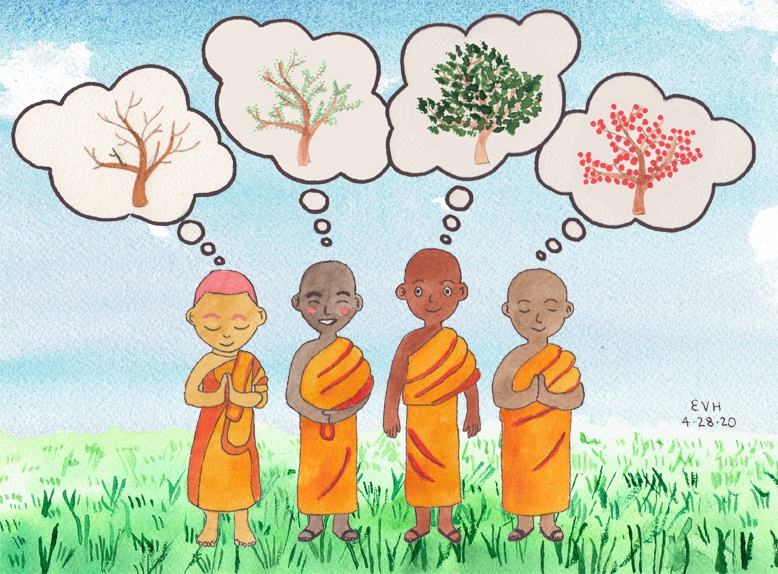
Jataka 248
Kiṃsukopama Jātaka
The Riddle Tree
as told by Eric Van Horn
originally translated by William Henry Denham Rouse, Cambridge University
originally edited by Professor Edward Byles Cowell, Cambridge University
The theme of this Jātaka is also the theme of the Kiṃsuka Sutta, which is 35.204 in the Saṃyutta Nikāya.
This Jātaka is about one of my favorite themes in the Buddha’s teaching – one that is often misunderstood – and that is that awakening is obtained in different ways depending on the person’s temperament or personality. It is like a room with many doors that lead into it. One person may have boundless lovingkindness, and that is their door to awakening. I think that the meditation teacher Sharon Salzberg is like that. Another person may be very analytical – like Sāriputta – and that is their door. Some people – like Moggallāna – have great psychic ability, and so on. The suttas are full of stories that document the different ways in which monks and nuns attained an awakening.
This is one reason that I am not enamored of the Abhidhamma, which tries to create a one-size-fits-all, mathematical/scientific/cookbook way of awakening. Buddhist practice is more like art, where many different students can take the same art courses yet all of them will produce very different kinds of art.
“All have seen.” The Master told this story while he was staying at Jetavana. It is the story about the Judas tree (the botanical name is “Butea Frondosa”).
Four brothers approached the Tathāgata (the Buddha) and asked him to explain the means by which one can awaken (become an arahant, a fully enlightened person). He explained how to do this. This done, they went off to different places where they spent their days and nights. One of them, having penetrated the Six Spheres of Touch (the six sense bases: touch, sight, sound, taste, smell, and mental formations), became an arahant. Another did so by penetrating the Five Elements of Being (the five elements: earth, air, fire, water, and space). The third after penetrating the Four Principal Elements (the brahma viharas: compassion, lovingkindness, empathetic joy, and equanimity). And the fourth after penetrating the Eighteen Constituents of Being.
(The “Eighteen Constituents of Being” are the qualities unique to a Buddha. They are: (1) no faults in the action of the body, (2) no faults in the action of the mouth, (3) no faults in the action of the mind, (4) impartiality, (5) constant concentration of the mind, (6) insight into all things and absence of attachment to them, (7) untiring intention to lead people to salvation, (8) incessant endeavor, (9) consistency of teachings with those of other Buddhas, (10) perfect wisdom, (11) perfect emancipation, (12) perfect insight, (13) consistency of deeds with wisdom, (14) consistency of words with wisdom, (15) consistency of mind with wisdom, (16) knowledge of the past, (17) knowledge of the future, and (18) knowledge of the present.)
Each of them reported to the Master the particular way in which he had awakened. Then one of them said to the Master, “There is only one nirvana for all these different paths of practice. How is it that all of them lead to awakening?” The Master replied, “This is like the people who saw the Judas tree.” They asked him to tell them about it, and he told them this story from the past.
Once upon a time when Brahmadatta was the King of Benares, he had four sons. One day they sent for the charioteer, and they said to him, “We want to see a Judas tree. Show us one!”
“Very well, I will,” the charioteer replied.
But he did not show it to them when they were all together. He took the eldest one to the forest in the chariot and showed it to him at the time when the buds were just sprouting from the stem. To the second one he showed it when the leaves were green. He showed it to the third one when it was blossoming and to the fourth one when it was bearing fruit.
After this had happened, one day the four brothers were sitting together and one of them said, “What sort of a tree is the Judas tree?” Then the first brother answered, “It is like a burned stump!”
And the second cried, “It is like a banyan tree!”
The third one said, “It is like a piece of meat!” (It has pink flowers.)
And the fourth said, “It is like the acacia!” (a type of shrub)
They were confused by each other’s answers and ran to find their father. “My lord,” they asked, “what sort of a tree is the Judas tree?”
“What did you say to that?” he asked. They told him their answers. The King responded, “All four of you have seen the tree. But when the charioteer showed you the tree, you did not ask him ‘What is the tree like at a particular time, at some other time?’ You made no distinctions, and that is the reason for your mistake.” And he repeated the first stanza:
“All have seen the Judas tree —
What is your perplexity?
No one asked the charioteer
What its form the livelong year!”

Figure: The Judas Tree the Livelong Year!
The Master, having explained the matter, then addressed the brothers: “Now as the four brothers, because they did not make a distinction and ask, fell in doubt about the tree, so you have fallen in doubt about the right path.” And in his perfect wisdom he uttered the second verse:
“Who know the right with some deficiency
Feel doubt, like those four brothers with the tree.”
When this discourse ended, the Master identified the birth: “At that time I was the King of Benares.”
